Adrian Ghenie
Cloud Fever
15 NOV 2025 until 18 JAN 2026
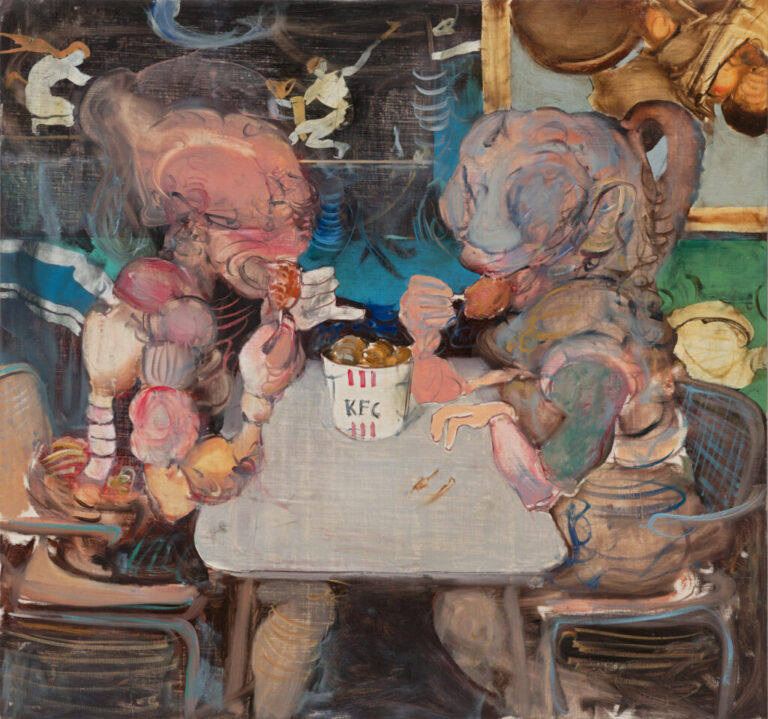
Untitled
2025
Oil on canvas
160 × 150 cm
Courtey of the artist and the gallery
It is a familiar, deeply commonplace scene: a person sitting at the breakfast table, hovering a fork with a piece of bread impaled over a plate of fried eggs. Next to the plate lies a smartphone with a brightly lit screen. Physical hunger and a craving for news and stimulation are demanding simultaneous satisfaction and we all know the dilemma: the coordinated transfer of food to the mouth requires a minimum of concentration – yet we are unwilling to take our eyes off the screen. We are looking at Adrian Ghenie’s painting The Breakfast, which sums up much of what has preoccupied the artist for several years now – ever since the bleak years of the Covid pandemic, to be precise. The exponential increase in daily time that people spend glued to their smartphones and tablets, submerged in what we somewhat euphemistically call social media, is what keeps neurobiologists awake at night – and anyone in charge of children.
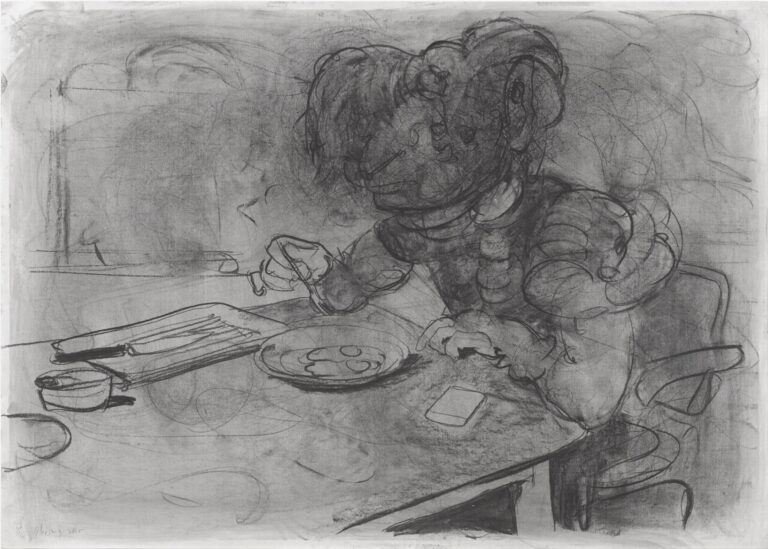
Study for “The Breakfast”
2025
Charcoal on paper
100 × 140 cm
Courtey of the artist and the gallery

The Breakfast
2025
Oil on canvas
105 × 140 cm
Courtey of the artist and the gallery
Last year, the term “brain rot” was named Oxford Word of the Year – and it is this buzzword that Ghenie draws on when asked about the trigger for creating the 8 paintings and 6 drawings (all in 2025) for Cloud Fever, the gallery’s sixth solo exhibition with the artist. The term refers to the impairment of cognitive abilities and the decrease of attention span caused by the endless consummation of low-effort, repetitive and – increasingly – fake digital content. In addition to sabotaging our ability to process complex thoughts, excessive use of social media can lead to a disconnection from reality and a decline in human exchange. Algorithms and artificial intelligence amplify emotional states and obsessions, and fake news tarnishes our sound judgment. Not to mention the deformation of the vertebrae of the neck, caused by the constant looking down. Nothing less than the upright walk, the hallmark of Homo sapiens, seems at stake. The digital conquest of our lives has the speed and impact of a pandemic, and we are all subjected to it. Some more than others.
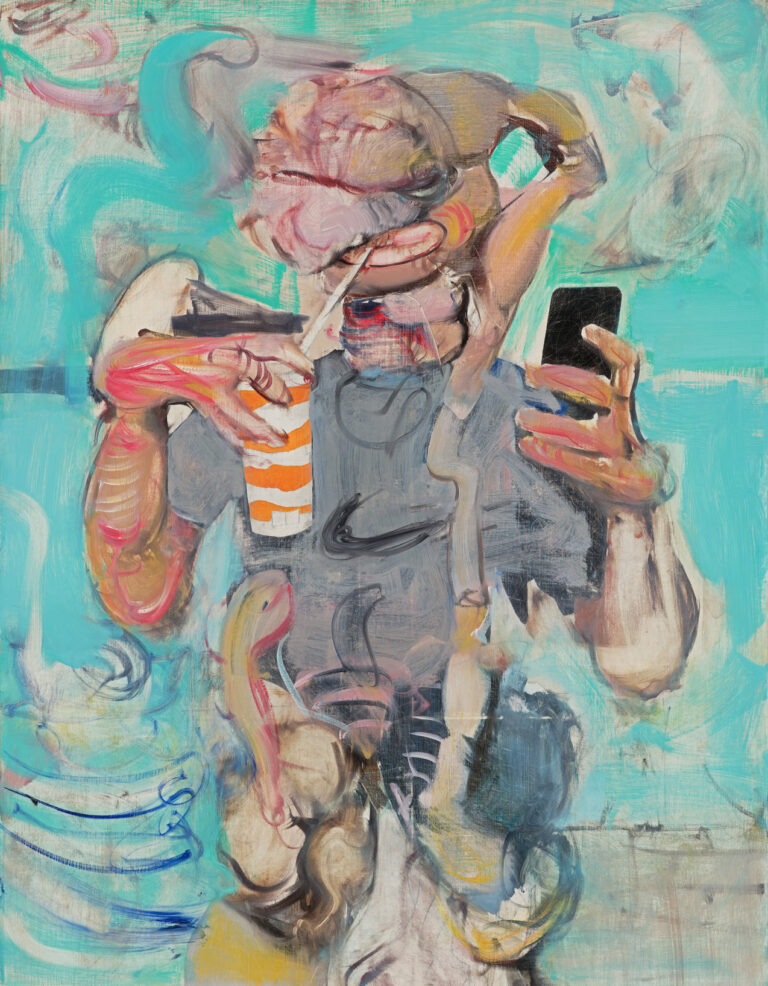
Teenager 2
2025
Oil on canvas
135 × 105 cm
Courtey of the artist and the gallery
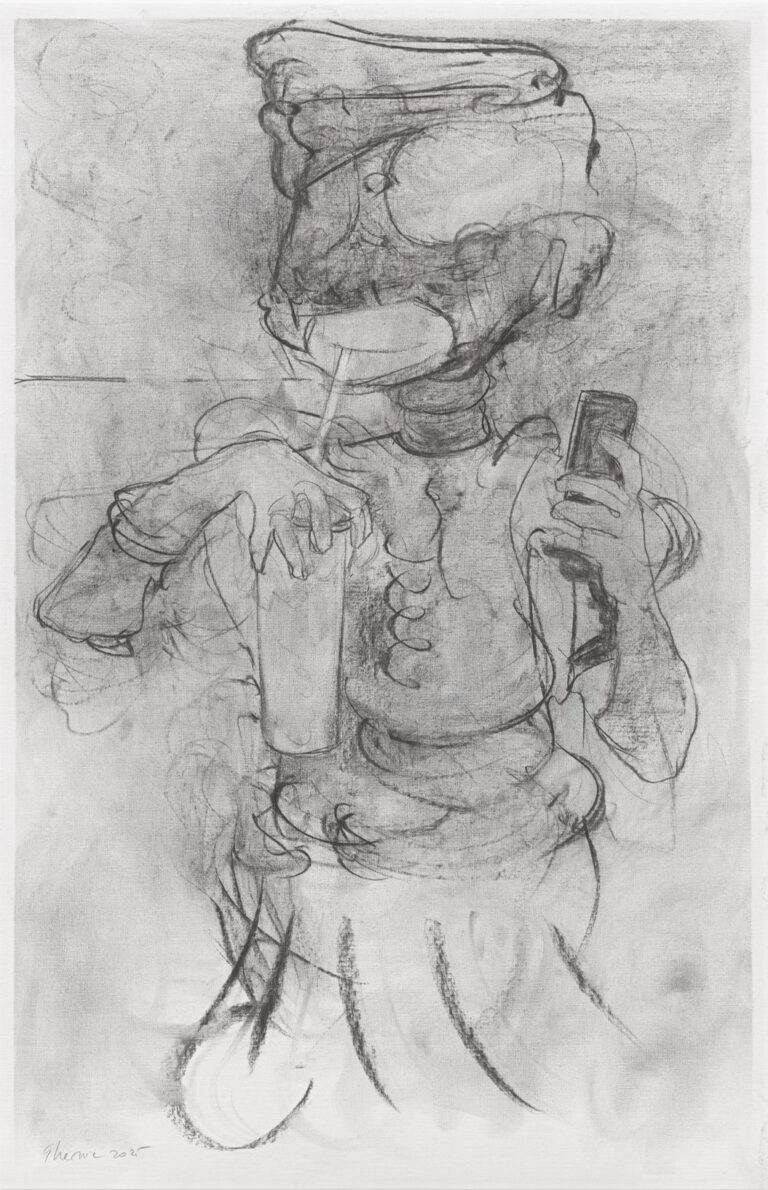
Study for “The Teenager 2”
2025
Charcoal on paper
100 × 65 cm
Courtey of the artist and the gallery
Adrian Ghenie belongs to the “others”. To this day, he has never engaged with social media. He does not use it to communicate with the world, nor does he resort to it to find out about what others think, do or “like”. He fully acknowledges that social media can also be useful. That Instagram, for example, has proven to be an empowering tool for many artists. But he himself chooses to do without it. So, when he is fascinated by the phenomenon that we shall now refer to, somewhat simplistically, as “brain rot,” and makes it the subject of a new body of works, he does so from the perspective of an outsider. In conversation, he has hinted that his interest also rooted in an element of envy (“but only 20%, the rest is horror”). An envy of the ease and efficiency with which young people in particular make use of the limitless technical possibilities now at their disposal – notwithstanding the fact that in conversation, he always appears to be perfectly informed and up to date.
Like the subjects of the series Ghenie has created in the past, his approach to this topic is that of an observer or a researcher. This scientific, observational approach was often that of a historian, but this time it is more like that of an anthropologist. He has turned his attention to a new type of human being, the “Homo digitalis”, which as a result of the breathtaking technological developments of the last 20 years, has access to more information and has a greater reach than we could ever have imagined, but at the same time feels deeply insecure and retreats into a digital cave guarded by algorithms. A major theme runs through Ghenie’s entire work: people’s susceptibility to new ideologies, especially in times of transition or in the aftermath of revolutions. May they be political ones (communism, fascism), scientific ones (Darwin’s theory of evolution) or the technical one we are currently witnessing, digitalization. One of the characteristics of ideologies is their claim to explain and interpret changing political and social realities. It lies in the nature of social media that, on the one hand, it enables information to permeate society more quickly and more extensively than ever before. On the other hand, it also promotes a high degree of fragmentation in political messaging and the segregation of like-minded people. So, it is not surprising that Ghenie incorporates the phenomenon of social media, its impact on everyday life, and the role it might play in the rise of ideologies into his art.
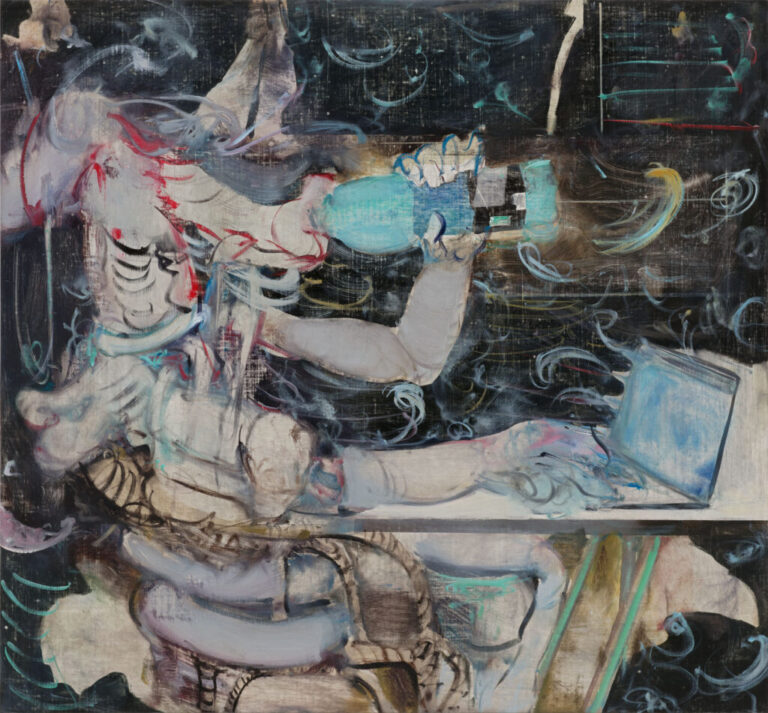
The Nightbird 2
2025
Oil on canvas
140 × 130 cm
Courtey of the artist and the gallery
Looking at the paintings and drawings themselves, and at the humanoid creatures that inhabit them, their deformed limbs and heads with indefinable physiognomies bring to mind the creature from Kafka’s novella The Metamorphosis, and characters from a wide range of science fiction films. Ghenie’s topical starting point, the brain rot, describes an inner condition, and as such cannot be represented by figurative means. Nor is that the artist’s goal. It is not without reason that he used the title “Impossible Body” for some of these creatures in earlier paintings. He is interested in brain rot as a new “texture” that may manifest itself in the overall composition, but not in the figure. The figure’s task is to illustrate the artist’s everyday life, which consists of a series of recurring routines. It may come as a surprise that an internationally successful artist would describe his everyday life in this way. But he insists that being an artist is like being a butcher or an office clerk. And he rightly points out that for most people, the routine nature of their lives has become even more pronounced through their use of social media. Reaching for the phone as the first thing after waking up and quickly swiping through the first 30 posts that the algorithm has compiled for us is, of course, exactly that: a new but already deeply ingrained routine. In the painting Untitled, Ghenie has depicted himself and his assistant at lunch in a fast food restaurant. In the background we recognize a Roman frieze like the ones you would find on a wall in Pompeii. Even in Rome, where Ghenie maintains a studio, fast food restaurants aren’t decorated in such a sophisticated manner. So, the “impossible bodies” are joined by an impossible decor. In the same spirit, Ghenie painted what is perhaps the most surprising picture in the exhibition, Figure with Chicken. It does indeed show the eponymous chicken-eating figure, but the composition is majestically ruled by a strikingly patterned tablecloth. Its floral print, reminiscent of Matisse, is more likely to be associated with a visit to grandma’s than a visit to a fast food restaurant. In Dune we see a figure watching the film based on Frank Herbert’s books. Like messaging on our smartphones, streaming movies has become a matter of course that, in theory is providing us access to the riches of film history, but in reality, has cemented yet another routine. The figure in the painting Nexus has put its phone aside and is reading the bestseller written by Yuval Noah Harari on the history of information networks. Its last chapter deals with the risks and dangers that lie in Artificial Intelligence. The presence of an analog book, written by a human being, offers some comfort in this digitalized world. As do, in a strange way, the fried eggs in the above mentioned The Breakfast, and the loaf of bread. In The Nightbird 2, we encounter two behavioral traits of the “Homo digitalis.” On the one hand, there is this nocturnal activity. The figure is probably way past its bedtime – but cannot tear itself away from the screen. The times of day have lost their structuring function. On the other hand, as in The Breakfast, we see the challenging simultaneity of eating or drinking and operating an electronical device. It is as if the uninterrupted physical connection to a keyboard has become a vital element of the human metabolism. The same is true for the figure in Teenager 2. Drinking with the help of a straw at least offers the advantage of an unobstructed view onto the screen.
And then there is The Acrobat, a painting that does not seem to fit into this series in any way. In the foreground, a larger figure sits on a cube-shaped seat, its chest largely fleshless. Behind it, a more delicate figure balances on a ball, holding its arms up in the air. There is no cell phone in sight, nor any fast-food packaging – which immediately lends the image a certain calm and dignity. In fact, 120 years lie between the scenes that appear in Ghenie’s other paintings and the source for this composition. He was inspired by a work from Picasso’s Rose Period: Young Acrobat on a Ball from 1905. When asked how this painting fits into the exhibition, Ghenie explains that it is an attempt to convey how much our world has changed in just over a century. Picasso’s circus acrobats face each other, and you can sense that there is a connection between them. This is a feeling that Ghenie cannot offer his protagonists. The technique Picasso and Ghenie have used to create their paintings has not changed in 120 years. It is a deeply analog medium, which is one of the reasons Ghenie values it so much. Which leaves us with the question: What might the great innovator Picasso have done with today’s tools?
